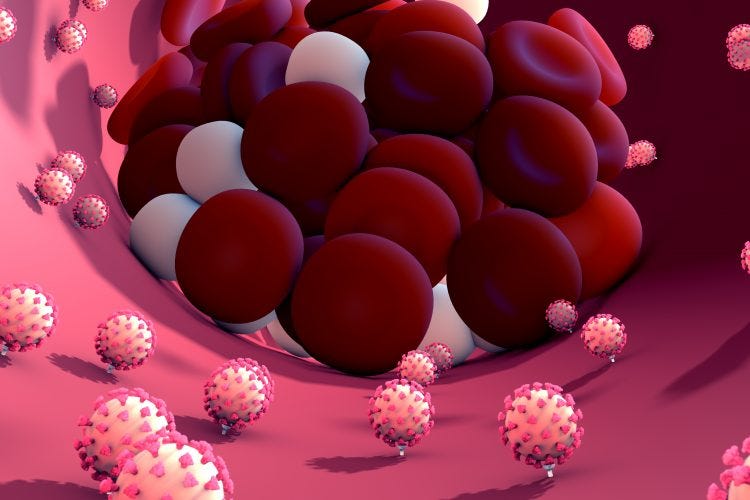COVID-19 is mainly a blood-borne disease
Despite the initial hypothesis that COVID-19 targets the lungs the most, it turns out the blood is the ultimate target
Although SARS-CoV-2 was shown not to be capable of spreading via the blood, researchers later discovered that it is the bloodstream that is mostly affected by the pathogen, in spite of being named a respiratory disease. A hint of this is the fact that the virus enters cells containing the ACE2 receptor on their surface, and this receptor has an important involvement in the regulation of blood pressure. Perhaps, this explains why patients with more severe forms of the disease and with long COVID are more prone to developing hypertension. Moreover, the development of autoantibodies following infection may not be that uncommon after all, and researchers discovered a stronger association between the development of autoantibodies and events like blood clotting and the development of long COVID.
The good news is that the immune system most of the time manages to filter out the virus before it reaches important blood vessels, especially in the cases of younger and healthier people. The bad news is that people with co-morbidities are more prone to SARS-CoV-2 infection of bigger blood vessels and consequently, to the development of complications. The reason why the virus has to go through a thorough immune filtering system first is because it first infects the nasopharynx, where mucosal immunity resides, and this part of the immune system is more specialised to tackle viruses as such. Furthermore, even if the virus reaches the lower respiratory tract, it would have to cross another immune barrier before reaching blood vessels that take O2 from the alveoli. As a result, people with stronger immune systems have a pronouncedly higher probability to only develop mild forms of disease.
Nevertheless, around 10% of people who experienced COVID-19 developed various forms of long COVID, and the scientific community was often puzzled at the operating system of the disease. Certain symptoms could not be explained completely, until a group of scientists in Germany discovered that long COVID patients have slightly modified forms of their eye capillaries. Following further analysis, they discovered that blood cells in these patients do not change their shape and so, they cannot travel as much to opposite sites of the body. As a result, there will be increased demands of oxygen intake by key tissues and likewise, symptoms of brain fog, tiredness and even loss of sense or taste after the recovery from the infectious disease now have an explanation. One important cause of these changes in the circulatory system is the development of autoantibodies, which means that autoimmunity induced by COVID-19 can play a major factor in the development of long COVID. The group of scientists developed a drug called BC007, which contains a DNA sequence, and they set this sequence to target and neutralise the produced and circulating autoantibodies. The administration of the drug was strongly associated with symptom improvement and a decreased duration of long COVID.
Given that all pathogenic agents have a specific sound frequency, we could develop a sound-based therapy to target the concerned pathogen (in this case, SARS-CoV-2) and neutralise it. In other words, we could be using principles by Dr. Rife to mitigate the pandemic. High frequency-based sounds are generally associated with better outcomes of numerous diseases because these sounds favours an alkaline internal environment over an acidic one, and likely, health over disease. Furthermore, intubated COVID-19 patients could be administered Ultraviolet A (Ali Rezaie et al, 2021) and Ultraviolet C rays through their tracheal tube as a way to reduce the viral load in the trachea and the bronchi, and alleviate excessive inflammatory responses. The therapeutic approach could be proven a substantial success and a contributor to the mitigation of the pandemic (Stanislaw P Stawicki, 2020).
Reference:
Salk Institute scientific article indicating that SARS-CoV-2 primarily targets the circulatory system, although it affects the respiratory tract as well, available at: https://www.salk.edu/news-release/the-novel-coronavirus-spike-protein-plays-additional-key-role-in-illness
Journalistic article reporting on the success of long COVID research and the development of the BC007 drug to neutralise the autoantibodies that were sustaining the disease, available at: https://dw.com/en/tracking-long-covid-in-the-blood/av-60658430
Rezaie, A., Melmed, G.Y., Leite, G. et al. Endotracheal Application of Ultraviolet A Light in Critically Ill Patients with Severe Acute Respiratory Syndrome Coronavirus 2: A First-in-Human Study. Adv Ther 38, 4556–4568 (2021). https://doi.org/10.1007/s12325-021-01830-7
Stawicki SP. Could tracheo-bronchial ultraviolet C irradiation be a valuable adjunct in the management of severe COVID-19 pulmonary infections?. Int J Acad Med [serial online] 2020 [cited 2022 Feb 28];6:156-8. Available from: https://www.ijam-web.org/text.asp?2020/6/2/156/287946



